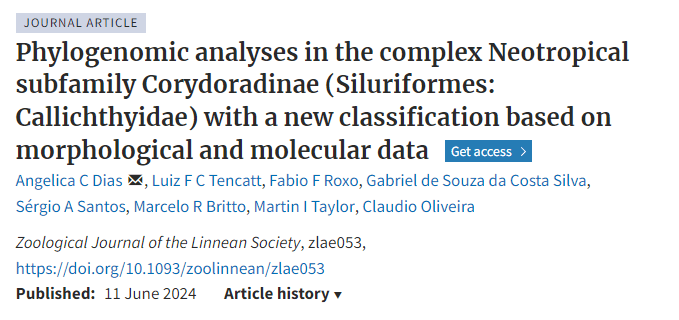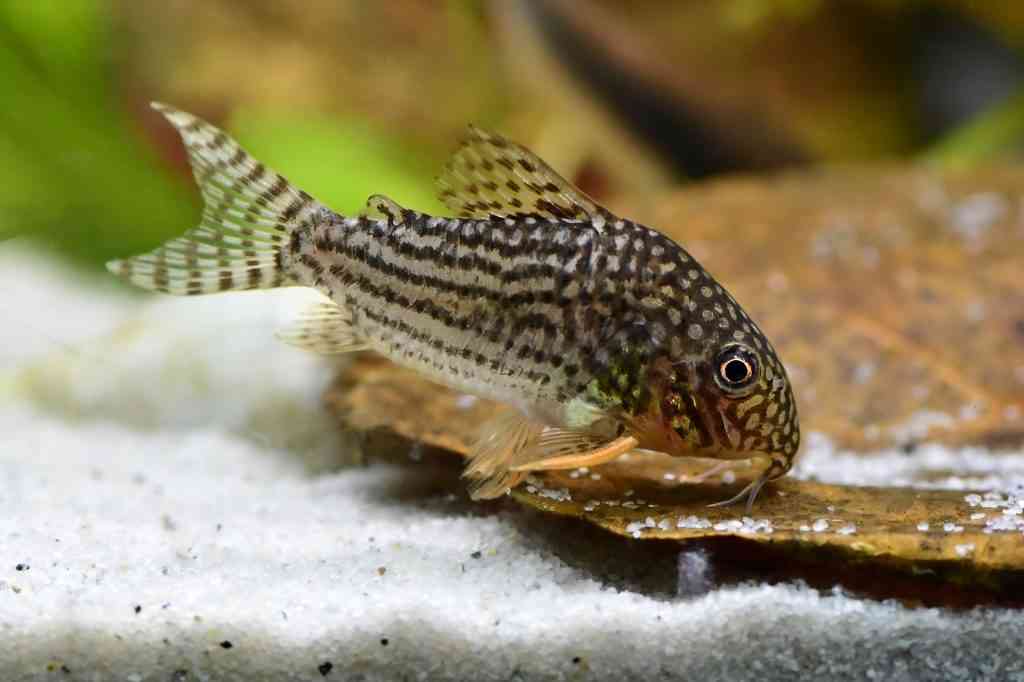Dr. Nora Hickey has been passionate about cory catfish since she started in the hobby and has now advanced to keeping several uncommon species in her blackwater aquariums. Jen interviewed Nora to learn more about how she got hooked and her future plans for her cory cats.
Recently, the Fishkeep & Chill team got together to well, Fishkeep & Chill! I visited Nora at her home in Pullman, Washington. Not only did I bring her a few young pairs of the F1 Betta albimarginata I reared, but we spent a few days playing with her aquariums, working on the website, writing, and most importantly, photographing her beautiful Corydoradinae catfish. I learned more about what sparked Nora’s interest in these catfish and have really started to get hooked on them again myself!
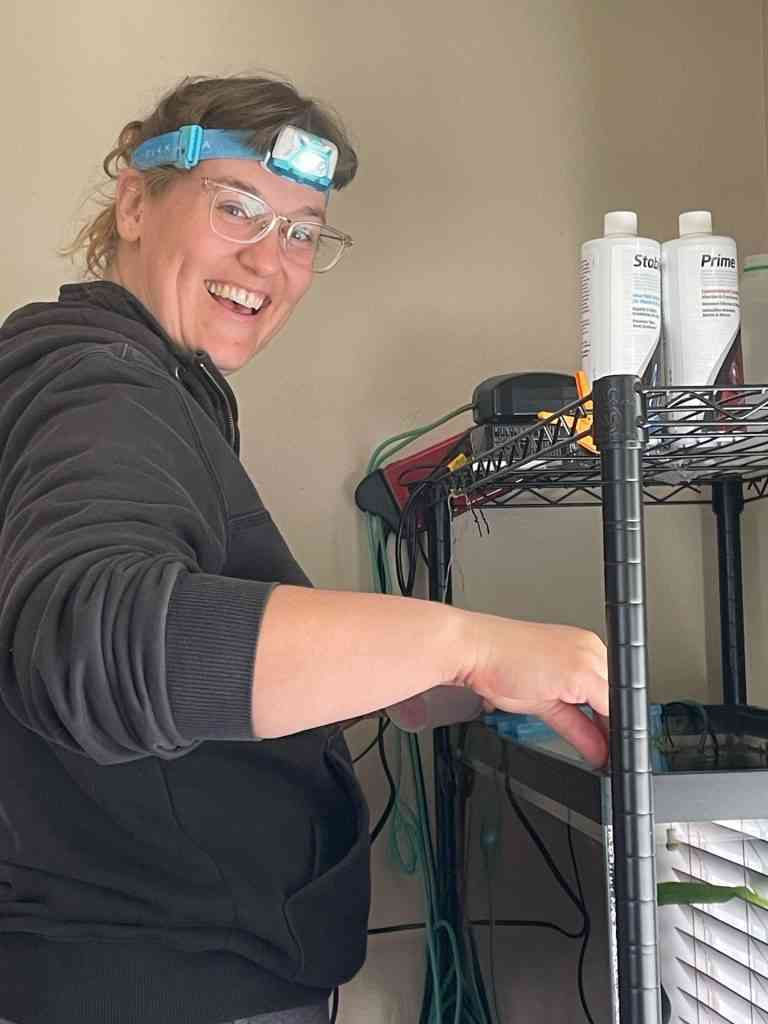
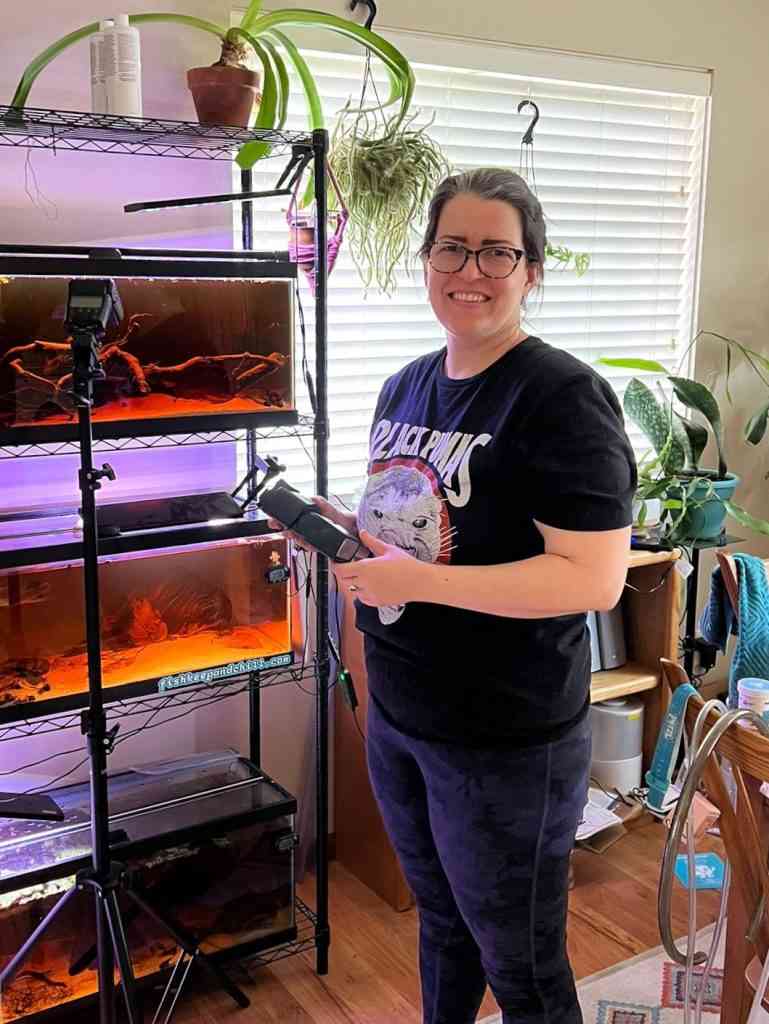
Nora has been a fan of this charming sub-family of catfish for as long as she can remember:
“I think I have pretty much always had an aquarium with cory cats. I would have had Hoplisoma paleatum in my first community tank, and I got pretty into the panda corys (Hoplisoma panda) when I was older. They were actually the first fish I bred aside from livebearers in middle high school. I also got Scleromystax barbatus around then—those are the ones I remember the most, they are so striking!”
What is it she most appreciates about cory cats?
“I like them because you can keep them in almost any tank—they are super peaceful but can also defend themselves! I feel there are very few scenarios where they aren’t successful in a tank. Also, with their spines, other fish tend to leave them alone. I mean, I can’t keep any other fish with my blind cave fish (Astyanax mexicanus) right now, but the peppered corys (H. paleatum) are fine with them. Being able to have a giant school is a plus, and it is adorable when they snuffle along in the sand as a group.”
More recently, she decided it was time to devote a few new tanks exclusively to housing groups of cory catfish. She is keeping Hoplisoma davidsandsi, Hoplisoma simile, H. paleatum, and a species currently only known as Hoplisoma sp. CW051. Since Jen’s visit, she has also added Hoplisoma atropersonatum (it’s not an addiction, she swears).
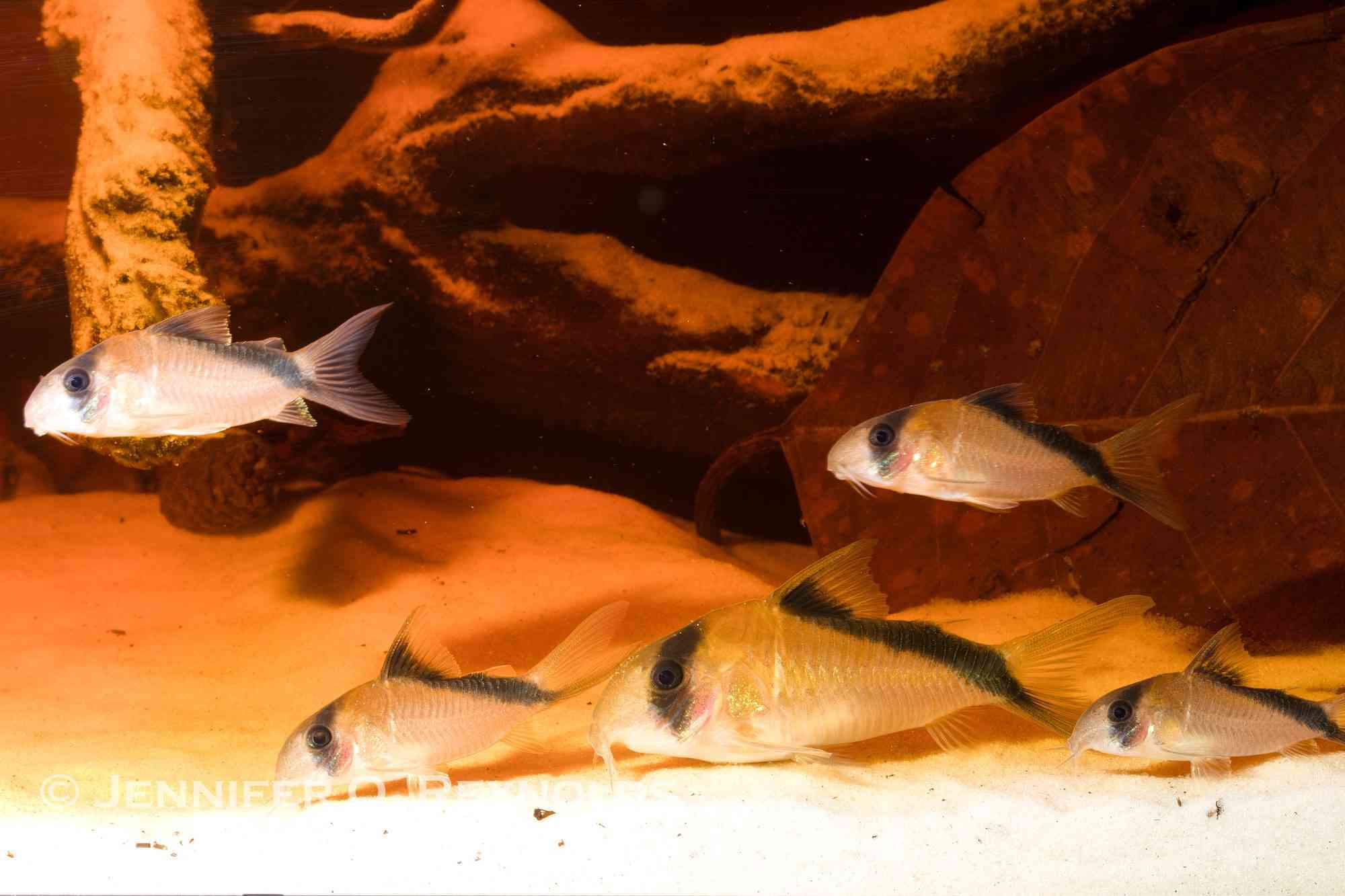
“I was inspired by my visit to you in Vancouver earlier this year. Your wild betta blackwater tanks—especially the one 10-gallon bookshelf tank you have with the Betta api api—are incredible! And seeing the amazing corys your store in Van, April’s Aquarium, is bringing in from Aquarium Glaser made me realize that some of my bucket list species are becoming more and more accessible. I am still looking for some Brochis species next. I really like Brochis seussi and Brochis robineae.“
Her focus on the Corydoradinae catfish hasn’t been without a few bumps in the road, however. The recent revision of the genus threw Nora and other cory catfish aficionados for a loop in adjusting to the new nomenclature.
“I woke up on June 11 2024 and learned I had gone from owning many species of Corydoras to owning zero species of Corydoras, and I have been in an identity crisis ever since!”
The species she has been keeping were reclassified from the genus Corydoras to the genus Hoplisoma as part of an important and major revision to the subfamily Corydoradinae. Nora is putting in a solid effort to get up to speed on the changes though and has a copy of the paper printed out and bound for studying. It made for good reading material during my visit, too!
Nora’s first target species to acquire for her new tank rack was H. davidsandsi.
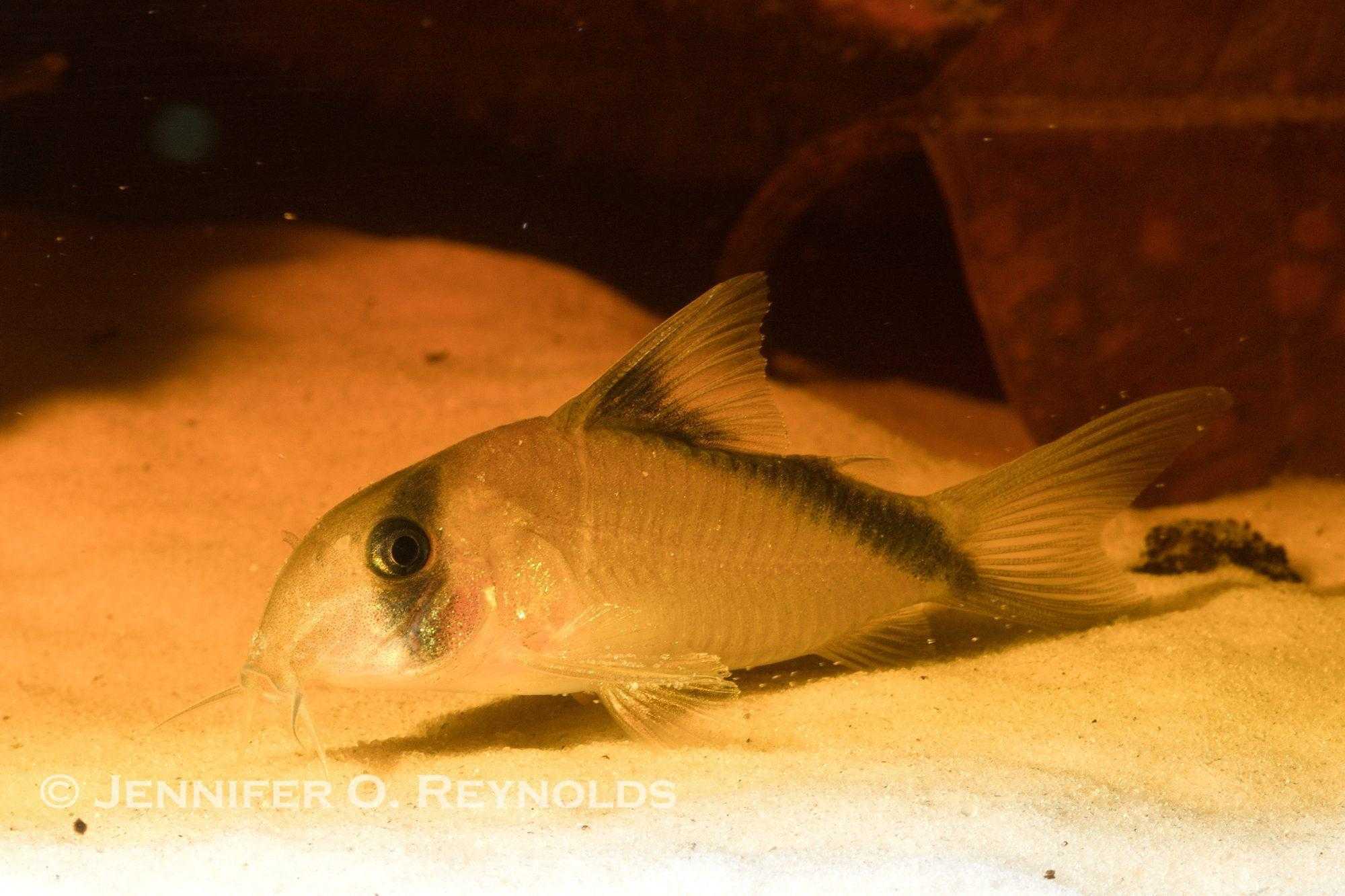
Nora had some formative experiences with this species and knew exactly how she wanted to set the tank up. She came to know this species at the New England Aquarium where she was an intern with Scott Dowd, our aquarist colleague who had the foresight to introduce the two of us later on when he set us up to be roommates on the Project Piaba expedition to Brazil we both went on.
“I started as an intern with Scott in the Freshwater Gallery during my second semester of sophomore year of college. I interned three days a week at the aquarium and gave my friend Dorothy a recorder to take to class to record all the lectures so I wouldn’t miss out! I kept volunteering all of college after my internship finished. I did another internship during our January period in the Aquarium Medical Center, but after that I returned to volunteer with Scott in the Freshwater Gallery until I finished college. When I went back to visit after graduating, I would go back and make sure to do a volunteer day with him.”
The freshwater gallery at New England Aquarium is where she first saw H. davidsandsi:
“They were in the anaconda tank, and that was a cool display. Scott also added Discus to that exhibit partway through my time there. The anacondas were on dry ground in the back, but there was a dip in the front that had a three foot deep water area where the H. davidsandsi and all of the other fish were located. I initially liked them because they looked like panda corys (H. panda), but they are actually strikingly different. There were a lot of them in there—just a massive school, and they would swim up and down the glass and all over the exhibit.”
Then, she was able to see Corydoradinae catfish species in the wild on her first trip to Brazil’s Rio Negro with Project Piaba in 2014.
“On one of my first days on the Rio Negro, our boat stopped on an island, not far away from Manaus, where the water was pretty dark and still somewhat silty since we were near the wedding of the waters, where the whitewater Solimões joins the blackwater Rio Negro. We stopped the boat on an island and I went snorkelling there. It was just sand and a pretty steep drop-off from there. On the part of the sand right where the drop-off was starting, there was a big school of catfish snuffling along in the current. It wasn’t a huge group, but I saw at least 20 of them. I’m not sure that they were H. davidsandsi, but they were similar. I was just in awe that I was seeing cory catfish in the wild.”

When it came time to set up her recent cory catfish aquariums, Nora gave careful consideration first and foremost to the choice of substrate. She knew it had to be very soft and fine sand to be most healthy for the corys’ sensitive barbels and allow them to filter feed properly. She chose Caribsea’s Super Natural Moonlight Sand (Scott Dowd’s favorite), which has a grain size of 0.25-0.75 mm—very small, and it is also very smooth. As a bonus, it looks very much like the sand we encountered in the Rio Negro. As I was working on her tanks during the visit, I noticed how soft this sand felt to my fingers, so I can only imagine what a great choice it is for these catfish. I also noticed how easy it is for the catfish to sift this sand through their gill rakers and spit it out of their operculum as they search for food.
Next, Nora wanted to recreate the feel of a riverbank with the tea-stained blackwater the Rio Negro is named for. She also wanted to provide an acidic, softwater environment to provide the most natural environment for the catfish in the hopes of spawning them:
“I’m aiming to keep the pH at least below 7 and ideally between 5-6.”
While her tap water in Pullman is essentially liquid rock as it is very mineral-rich and high in pH, she was able to recreate more of a soft, blackwater environment by combining it with distilled water and adding driftwood and botanicals. She chose spider wood as the roots of this dried wood look a lot like roots protruding from the banks of the Rio Negro in the areas she snorkeled in.
She uses almond leaves and alder cones to provide foraging areas and dark tannins. The effect is show-stoppingly beautiful: the sloped white sand provides foraging areas and the tannin-infused water glows a rich reddish brown, and it is so dark you cannot see to the back of the aquarium where the spider wood roots protrude from. The catfish blend in perfectly with their cryptic markings and the effect feels so natural.
“The way they have the black line on their back, it sort of looks like a shadow of a leaf or the underside of a root.”
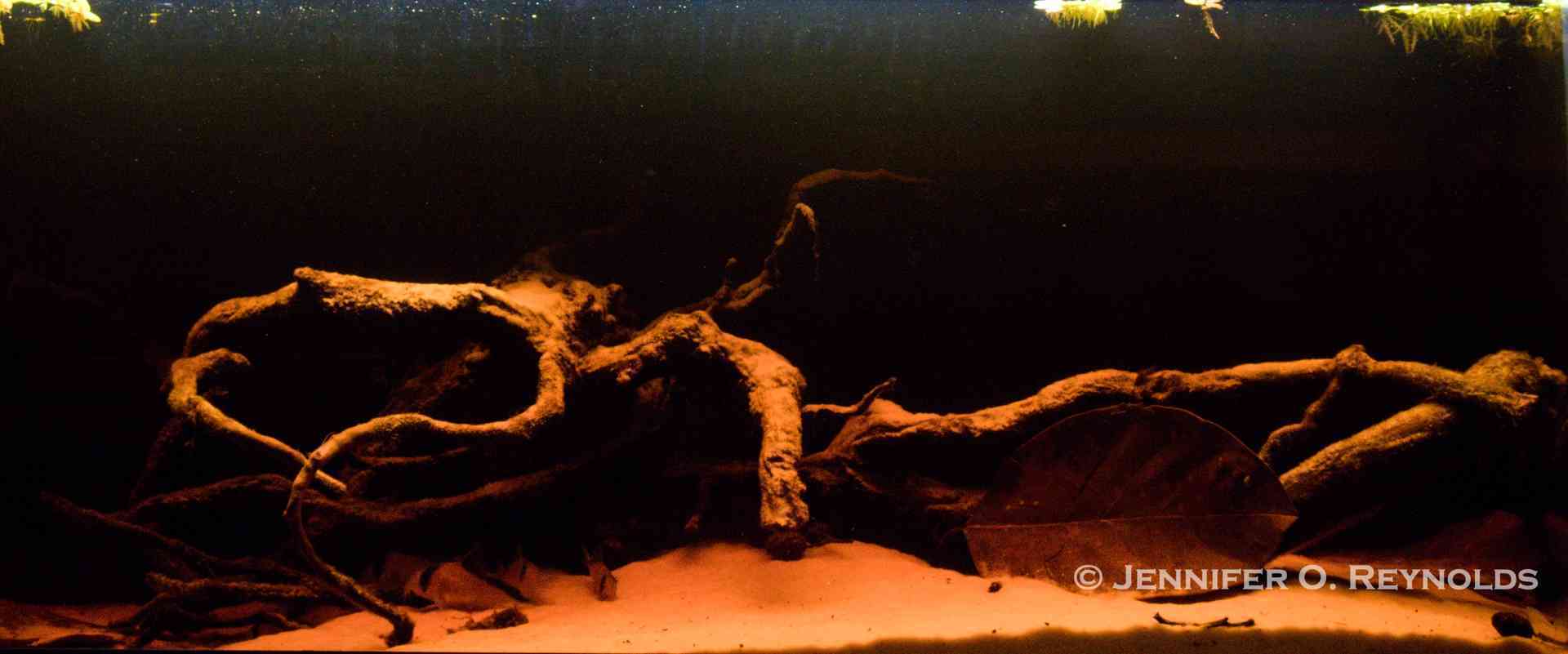
I noticed that the H. davidsandsi were somewhat skittish, as I had to stay very still to have a chance to photograph them, otherwise they would dash away. I asked Nora if she knew if they were wild caught:
“They’re really not seen on export lists from the Rio Negro region (I have been trying to find them for years through multiple importers). My three largest ones came from Europe, and I assume they were captive bred. The ten small ones I purchased from a breeder in the US who I connected with on Ian Fuller’s ‘Corydoras World’ Facebook group.”
However, as long as I sat patiently and observed, they would emerge in a group to snuffle through the substrate, searching for food and swimming against the flow. Nora has had good success using a small wavemaker in the tanks, and found that her cory cats appreciate the water flow from these or hang-on-the-back filters in addition to sponge filters. She keeps her cory catfish in 20-gallon long tanks for now, but is in the process of setting up 40-gallon breeder tanks for them.
A wonderful recent finding was that her three adult H. davidsandsi had spawned and, unbeknownst to her, a sole fry had survived to grow to about 1 cm (she found it the night before our visit, while she was clearing out the tank the adults had been in to make room for the Canadian B. albimarginata). The use of botanicals like alder cones and almond leaves in her tanks provides a food source that smaller fish like this little recruit can use. I was honoured when the adorable little guy made an appearance in the tank to be part of the photoshoot!
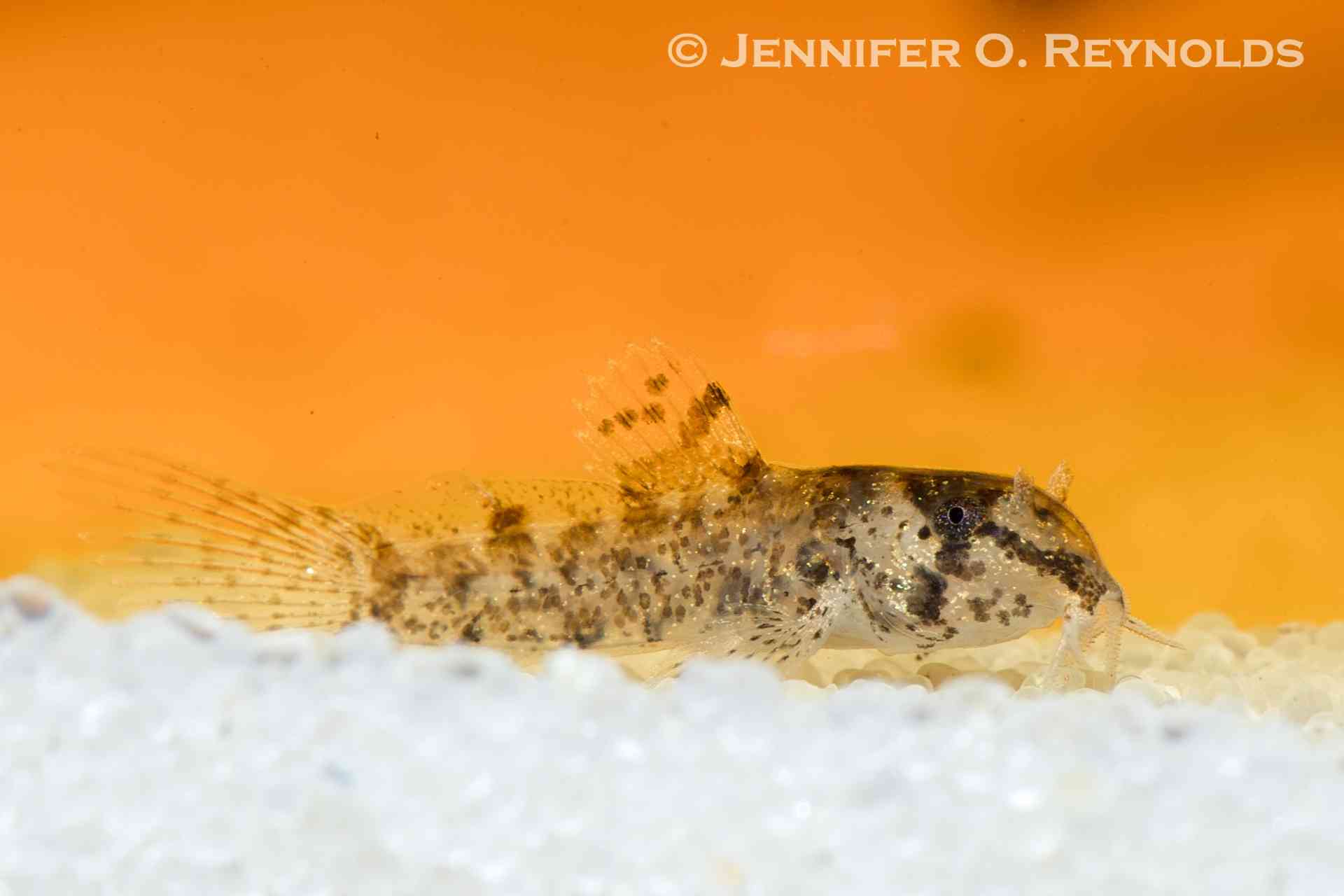
Nora also added tucano tetras (Tucanoichthys tucano) to her H. davidsandsi tank. While most people add cory catfishes to communities, not Nora—the tetras are added to her cory tank, not the other way around. She has designed her tanks to feature the catfish, which I really appreciated, and I bet they do, too.
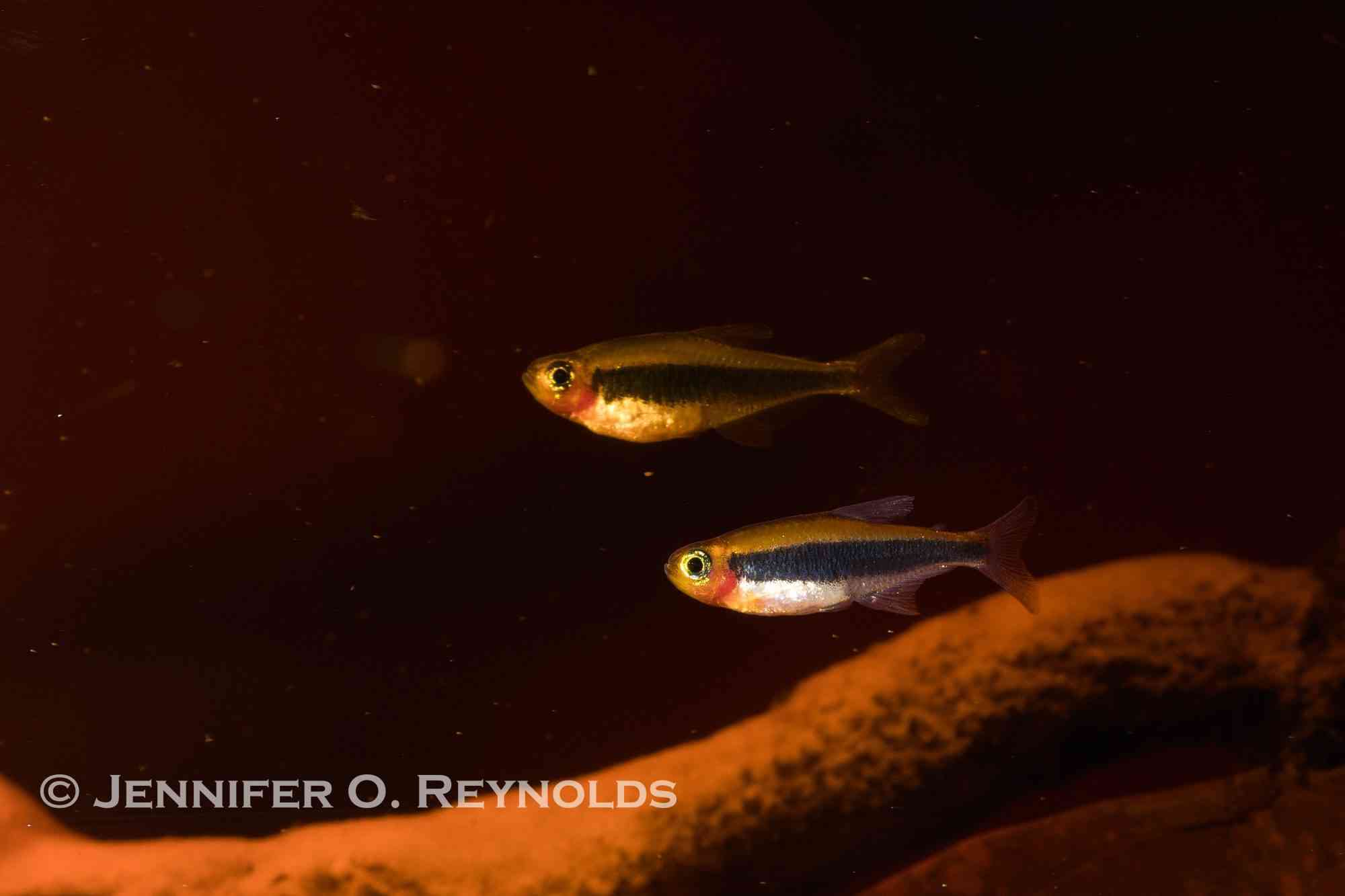
The next species Nora chose to focus on is commonly called “CW051”, or a giant panda cory. Nora has her own nickname for them, though—the “jumbo jets!” I thought this moniker really suited them, but I just had to ask her why she calls them that:
“They’re so big. And they’re so full-bodied, and they just kind of swim like I imagine a jumbo jet flies—which is not very elegantly, but very powerfully!”
Nora started laughing:
“When a jumbo jet takes off, it probably spits up a bunch of sand and stuff, and they do that too.”
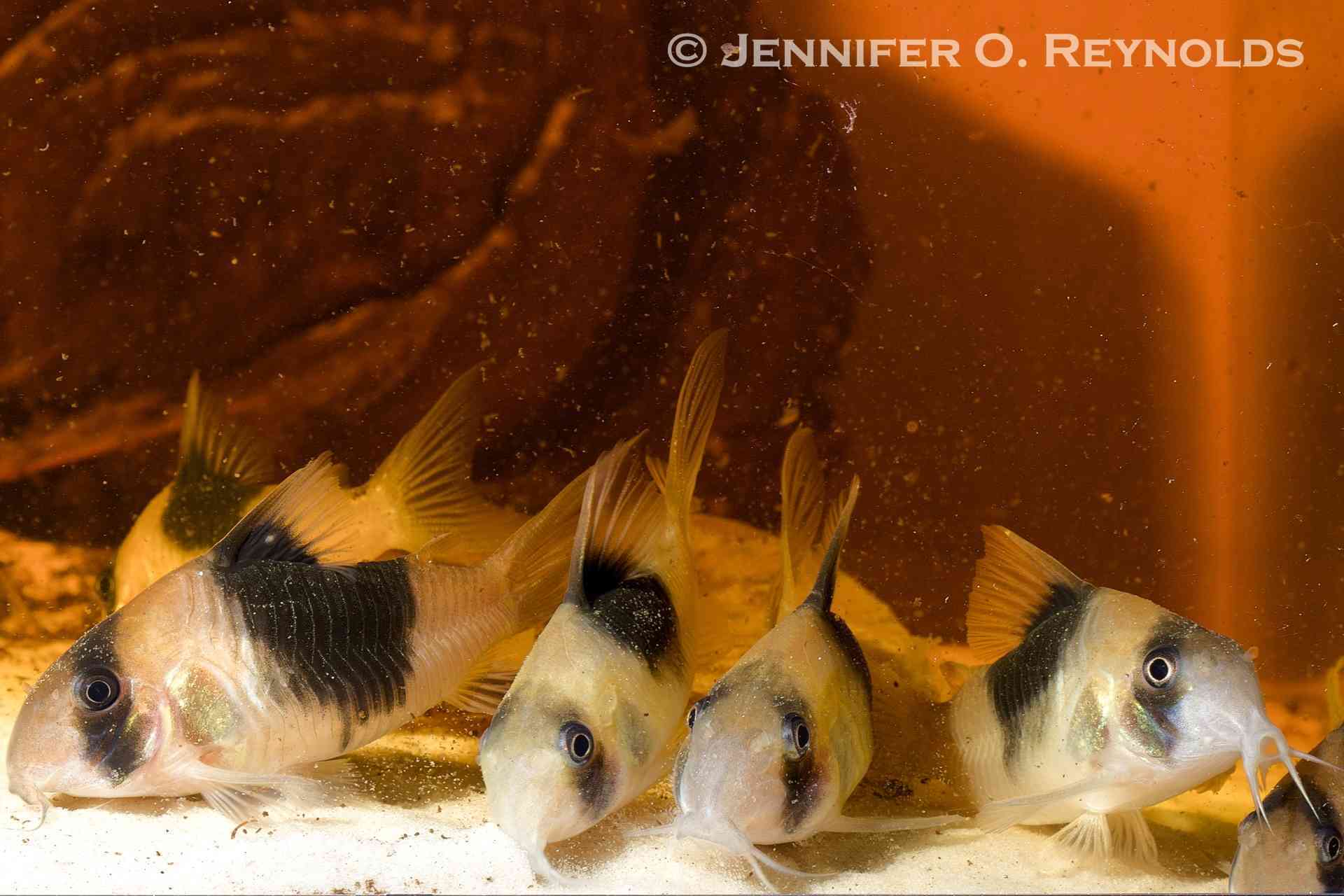
This catfish is expected to also be a member of the Hoplisoma genus. I have to admit, I really fell for these guys while I sat over several hours photographing them. Like Nora said, they’re big cory catfish. Sort of adorably large, and not particularly sleek, unlike the H. davidsandsi that just exude elegance. I couldn’t look away from these fish.

I always expect Corydoradinae catfish to be in the 1-1.5” range. Not these guys. They’re chunky—the biggest in her group are around 2” long, and quite thick and high-bodied. They prefer to rest under overhangs and in shaded areas as a group but will forage through the aquarium in a school, making their way across the tank to look for food.
As I followed them along, I enjoyed watching them sift sand and eject pieces of leaves out of their operculums as they searched.
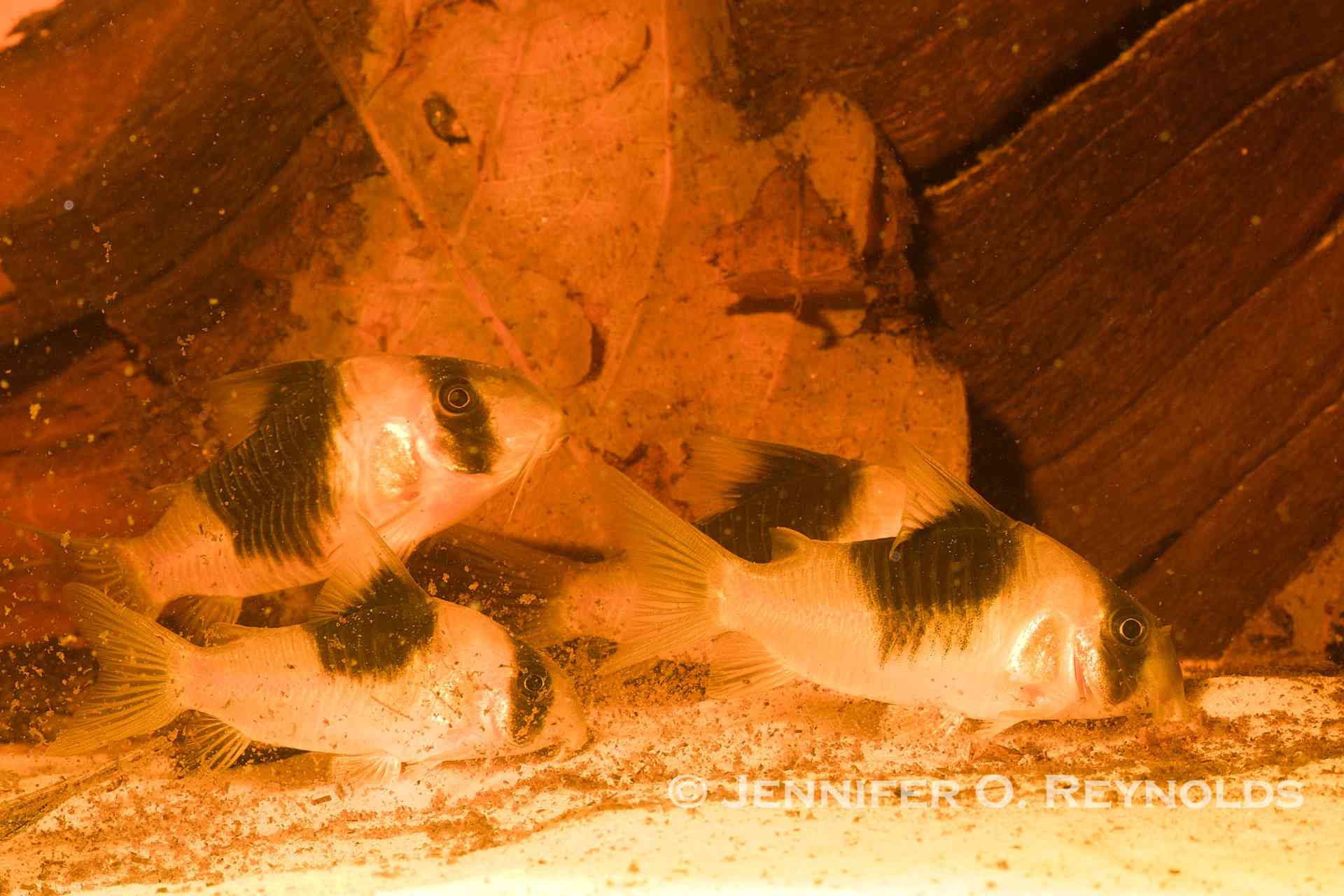
The black blotches are interesting, too: some of her specimens have a mid-body black blotch that extends all the way to the abdomen, while on others, the blotch stops halfway down. It seems this is either the result of different collection locations, or a natural variation. It will be interesting to find out how any young Nora is able to rear turn out in terms of the patterning of their large black blotch. I hope that if she spawns them, I’ll be able to have some of the offspring, as I became really fond of them.
What I appreciated about how Nora has gone about setting up her Corydoradinae catfish aquariums is that the catfish are the star of the show and their needs come first and foremost. Having the focus on the catfish gave me plenty of time to watch their foraging patterns, watch them do the funny little wink they do as they rest, and learn how they respond to different currents, lighting levels, and food items as I set up to photograph them.
As far as feeding goes, Nora offers a varied diet:
“They really like the Sera Vipachips. For the baby H. davidsandsi and juvenile H. simile I feed frozen daphnia. For the adult H. davidsandsi and jumbo jets, I give them mysis, bloodworms, adult brine shrimp gutloaded with spirulina. I feed them twice a day.”
Nora’s got lots of plans for her cory catfish hobby. Once she upgrades her current groups to larger tanks, she’ll look to acquire her other target species and focus on rearing young from these ones if she can trigger them to spawn reliably. She plans to expand her live food cultures to rear young and condition her adults, and she will keep working through learning the Corydoradinae revision backwards and forward. I will be sure to quiz her on my next visit!

